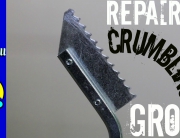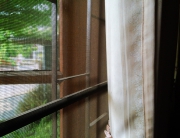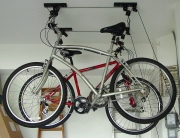December 30, 2014
How to Install a Ceiling Light Fixture. These written instructions accompany the video “How to Install a Ceiling Light Fixture Step by Step”.
Electrical Safety Precautions
The power of electricity should be respected. Electricians take basic safety precautions when working with electricity, and so should you, to keep yourself and your family safe.
Before proceeding with the job, read and observe the following safety guidelines.
- Always shut off the power to the circuit on which you will be working. If you are unsure, shut off the power at the main breaker.
- Post a warning sign on the breaker box to let others in the house know that you are working on the electricity, and to not touch the box. Lock the box if possible. Make sure that children and pets are not present in the working area.
- Test all the wires in the junction box to be sure they are dead. The best way to check this is with a voltage tester.
- Even after turning off the power, work as if the wires are live. Work in a methodical manner and double check the security of all connections before restoring the power.
- Wear protective shoes and clothing. Always wear rubber-soled shoes. Never work with wet feet or while standing on a wet surface. Avoid wearing jewelry, a watch, or clothing items that might get snagged while you are working.
- Don’t touch any metal while working. Make sure you grab tools by the handle (rubber-gripped tools are best). If you need to use a ladder, use a fiberglass or wooden one, NOT aluminum.
- Special Note: It is dangerous and is against code to connect copper to aluminum wire.
Tools & Supplies
- Needle-nose Pliers
- Wire stripping tool
- Phillips and flathead screwdriver
- Multi-purpose tool or utility knife
- Voltage indicator (Tip: To find out if your voltage indicator is working properly, try it out on a circuit that you know to be live)
- A new light fixture
- Wire nuts or connectors
- Grounding clip (may need)
- Electrical tape
- Flashlight (optional, depends upon where you are installing the fixture and if there is natural light available)
Steps to Complete Job
Part 1 – Remove Existing Light Fixture
1. The very first step is to take the appropriate safety precautions. If you have not already done so, review and observe the safety precautions listed above.
2. Disconnect and Remove the Existing Light Fixture.
- Remove the glass dome or whatever covering is over the light bulb.
- Remove the light fixture. Most of the time there should be 2, or at most 4 screws connecting the fixture to the ceiling. Many fixtures can be removed by simply loosening the screws and rotating the fixture.
- Note: Take note of how the three wires, black (hot), white (neutral), and bare or green (ground) are attached from the fixture to the junction box because you will be attaching the new fixture in the same manner.
- Disconnect the wires by removing the wire nuts.
- Disconnect the ground wire by loosening the ground screw and removing the wire.
- Remove the bar (bracket) that is attached to the box.
Part 2 – Install New Light Fixture
1. Familiarize yourself with the new fixture. Locate the ground, neutral and hot wires. The ground wire is bare, the hot wire is black, and the neutral is white. Locate the mounting bracket, on which there is often a green screw, to which the ground wire will be attached.
Special note about ground wires: Many junction boxes in older homes have either a hidden ground wire or no ground wire at all. It is also possible that the older fixture you removed had no ground wire. In any case, going forward, you will want to attach the ground wire on the new fixture to the junction box. In many cases (such as in the See Jane Drill video) there will be a green screw on the mounting bracket to which you will attach the ground wire. In some cases there may not be a green screw and you will need to use a grounding clip.
2. Attach the mounting bracket to the box. Use the screws that should be included with the new fixture. Test the bracket to make sure it is secure.
3. Attach the fixture:
- Attach the ground wire. Loop the copper (bare) wire around the green terminal on the bracket. Tighten with a screwdriver.
- Attach the hot wire. Attach the black (hot) wire on the fixture onto the black (hot) wire in the box by twisting the ends together and securing with a wire nut.
- Attach the neutral wire. Attach the white (neutral) wire on the fixture onto the white (neutral) wire in the box by twisting the ends together and securing with a wire nut.
Handy Tip from Leah: For added security, we always like to wrap our connections with electrical tape.
4. Tuck the wires neatly away into the junction box.
5. Make holes in insulation. You may need to poke holes through the insulation to attach the fixture to the screws on the mounting bracket. This can easily be done with a screwdriver as shown below.
6. Attach the fixture. Next, line the holes in the fixture up with the screws on the bracket, and install. Turn the fixture to put the screws into the correct position, and tighten the screws with a screwdriver. Ensure that the fixture is secure.
7. Attach the dome or covering. Put in a light bulb before attaching the dome or covering. Be sure to check the instructions provided with your new fixture because the installation of various light coverings can be different.
8. Turn the power back on at the breaker, and test the light. The light should come on.
And that is it. You did it! You have just replaced a light fixture.
by See Jane Drill, Copyright 2013
Note: It is the intention of See Jane Drill to educate and empower people to perform their own home repairs. However, if, after viewing the video and reading the safety precautions and instructions, you still feel uncomfortable with performing an electrical job, you may want to call an electrician. Safety is the number one priority.
Due to differing conditions, tools, and individual skills, See Jane Drill assumes no responsibility for any mistakes, damages, injuries suffered, or losses incurred as a result of following the information published on our website and in the videos and written instructions published through our website. Before beginning any project, review the instructions carefully, and if you still have any doubts or questions about how to complete the project, consult with local experts or authorities. Also, because codes and regulations vary greatly by location, you should check to ensure that your project complies with all applicable local codes and regulations. Always read and follow all the safety precautions provided by any tool or equipment manufacturer, and follow all accepted safety procedures.
See Jane Drill is dedicated to providing accurate and helpful do-it-yourself information. We welcome your questions, input and feedback about the information provided on this website.






Leave A Comment